This is an Argoflex EF twin lens reflex camera made by Argus, which was based out of Ann Arbor, Michigan. This Argoflex is the same as the Argoflex EM, except it has a flash synchronized shutter and a flash hotshoe on the side of the camera. The EM model itself was the successor to the earlier Argoflex E. All Argoflex models were solidly built with externally coupled lenses via gears that surround both lenses. The Argoflex was in production for a relatively short period of time, from 1948 – 1951. All Argoflexes except the very first Es used 620 roll film and could not use 120 film without modification. Although not high-spec models, they were built extremely well, and their solid metal bodies have proven to stand the test of time.
Film Type: 620 roll film
Lens: Argus Coated Varex Anastigmat 75mm f/4.5 coated 3 elements
Focus: 3.5′ to Infinity
Type: Coupled Reflex Viewfinder
Shutter: Wollensack Alphax Leaf Shutter
Speeds: T, B, 1/10 – 1/200 seconds
Exposure Meter: None
Manual (Similar Model): http://www.butkus.org/chinon/argus/argus_argoflex_e/argus_argoflex_e.htm
History
The design of the Twin Lens Reflex camera was already well established by German camera makers like Voigtländer, Rollei, and Zeiss-Ikon by the late 1930s. All models by any 3 of these manufacturers were well built, generally had good to great optics, and were expensive. At this time, American photographers wishing to own a TLR had no other choice but to import one of these models from Europe at a rather high cost.
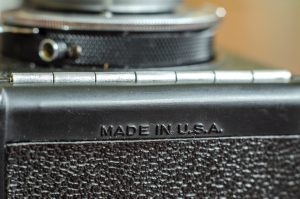
While several American companies were already making inexpensive 35mm and medium format folding cameras at this time, it was not until 1940 that an American made TLR would be available. The first two companies to do it were Ciro with the Ciro-Flex A and Argus with the Argoflex E. Ciro took an approach more closely similar to the German makers in that both the viewing and taking lenses would be mounted to a movable lens plate that would move forward and backward as the focus knob was rotated.
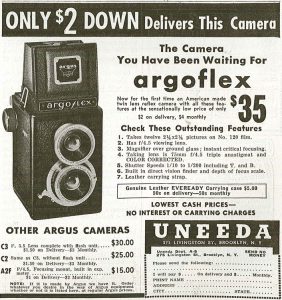
Argus however, took a unique approach in an effort to keep costs as low as possible. This was an approach they used with both the Argus A and C series 35mm cameras that worked quite well. Their new TLR would have a sold Bakelite body with external gears for focusing. The taking and viewing lenses would have an external gearing around both lenses which would link the rotation together. As one lens was rotated, the gears on one would move the other. In order to accomplish this, one of the lenses would rotate clockwise, while the other would rotate counter-clockwise.
Argus’ simpler design meant that they could offer the Argoflex E for as little as $35 in 1940, only $5 more than their most popular camera, the C3 rangefinder. In my research, I was able to find this ad for the Ciro Flex from 1940 that lists it’s price as $42.50. Although only a $7.50 difference, when adjusted for inflation that would be like a difference of around $127 in 2016.
Although simple in design, Argus’ design worked quite well and would inspire many other inexpensive TLRs after World War II would end. By the late 40s and into the 50s, several companies including Kodak, Ricoh, and Universal would all have externally geared TLR models available.
The Argoflex E would be Argus’ only pre-war TLR, and would eventually be replaced by the Argoflex II, EM, and EF models in 1948 which replaced the Bakelite body with a completely new solid metal body and added several new features. These metal bodied Argus TLRs would be the most sophisticated TLRs the company would make before reverting back to a plastic body and simpler design with the release of the Seventy-Five in 1949. By the mid 1950s, the Argoflex name would be reduced to extremely simple box cameras with fixed viewfinders and simple shutters.
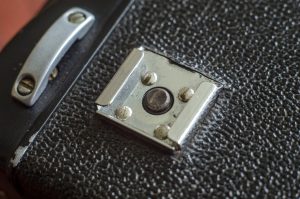
The Argoflex EF was the last of the metal bodied TLRs and was made from 1948 – 1951. It was identical to the Argoflex EM, except with the addition of a flash hotshoe. Although the hotshoe has an electrical contact in the center of the shoe like modern hotshoes, it uses a design that is incompatible with modern flashes. You must use a flash specifically designed for this model.
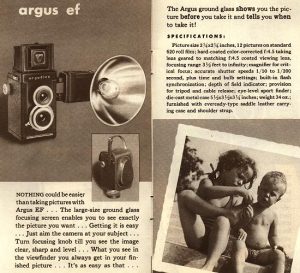
Today, the Argoflex TLR has limited appeal. There are those who have a fascination with American made cameras, and some who specifically look for Argus products, but beyond that small niche, you won’t see too many people looking for them. This is good in that prices have not been driven up for these models, and you can often find an Argoflexes for sale on eBay for as little as $10. Certainly there are better examples of the Twin Lens design, and even better American made examples, but still, the Argoflex did play an important role, albeit a small one, in the history of American camera design and for their cheap price, deserve a spot in any collection.
Repairs
Although the Argoflex was in good physical shape when I acquired it, it had clearly not been used in a very long time and had suffered the ravages if time. The shutter was completely gummed out and would not fire at all. The whole camera, including the viewfinder needed a good wiping down, but I would have to take apart the shutter to clean it if I ever hoped to use it.
Thankfully, the shutter on this camera is the same Wollensak Alphax that was on my Ciroflex Model D which I took apart several months ago. I discuss the cleaning and assembly of the shutter in that thread which you can read here as I don’t want to duplicate too much information here. Another really great resource for cleaning and servicing Alphax shutters is from Daniel Mitchell’s Camera Collecting and Restoration website. He has detailed instructions with pictures that show how to take apart an Alphax shutter and clean it. Between these two resources, you have all of the information you should need to clean the shutter on the Argoflex EF.
Before you do that however, you need to actually get to the shutter, which is hidden behind the two geared rings around the taking and viewing lenses. You must remove the two cosmetic name plates that are inside of the geared ring. These are glued in place from the factory. Over time, this glue should be pretty dry and brittle, so it only takes a small amount of effort from a hobby knife or very small flat head screwdriver to pry both plates off.

Before you go any further, it is very important to note the position of the taking and viewing lenses when the camera is set to infinity! Do not go any farther until you do this. Set the camera to infinity, and with a black magic marker draw a line between the two gears where they mesh together. This will indicate where the gears need to be when reinstalling them later. You also need to make a note of the height of each gear from the body of the camera. Infinity is not the same thing as the lenses screwed in all the way. Take a digital picture of the height of these gears from the side so you can refer to it later. Look at the image to the left and you can see a black mark in between the two geared rings indicating their correct position at infinity.
I borrowed the image to the left from the excellent guide for restoring an Argoflex EM from David E. Gaon. Although he is restoring an EM, this part is the same for the EF. It’s also worth noting that his guide goes a lot farther into the camera than just a simple shutter cleaning. Many of his “tools required” are not necessary for the shutter. He covers everything, including converting the Argoflex to use 120 film instead of 620.
If you do not pay attention to the height or the orientation of the gears, you will not get the focus correct when reassembling the camera later. If you somehow forget this step and proceed to remove the gears, all is not lost. It is still possible to get it installed correctly, but it takes a ton of trial and error, collimating, measuring, and recollimating until you get it right.
Once you have access to all of the screws underneath the front plate, have marked the gears at infinity, and have taken a picture to remember the height of the gears, you can start taking things out. Like with any camera, make sure you keep track of all of the screws and pieces so you don’t lose anything. It helps to take many pictures with a digital camera or smartphone after removing each piece, so you can remember how to put it back together later.
For the most part, if you see a screw, it needs to be removed until you get to the shutter. The taking lens is screwed on “righty tighty/lefty loosey”, but the viewing lens is backwards, so its “righty loosey/lefty tighty”. This is necessary since the two gears need to turn opposite of one another.
Remove everything until your camera looks like the image to the left. You’ll notice two black screws inside that black metal ring around the taking lens. These are the focus stops and do not need to be removed, so leave them be.
Remove the two silver screws in the Alphax shutter fascia and lift that ring off. Do not attempt to remove the inner lens element, it is attached to the plate beneath the Alphax fascia and will just lift out later.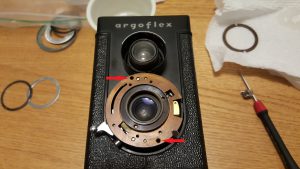
Your camera should look like the picture on the right. Remove the two long screws in the screw holes indicated by the red arrows (I had already removed them when I took this picture), and lift off the brown metal ring. The middle taking lens is attached to this ring and will lift off with the ring. Put it somewhere so you do not scratch the lens.
At this point, the innards of the Alphax shutter are exposed. Earlier in this section I refer to my Ciroflex review along with a guide by Daniel Mitchell on how to service the Alphax shutter. Follow those guides, but for your reference, here is a gallery with some short explanations of the picture which should help you in disassembling, cleaning, and then reassembling the shutter.
After cleaning the shutter, reassemble everything in the opposite of how you took it apart. When it comes time to put the geared rings around the viewing and taking lens, I found it easier to start with the viewing lens gear first, and then install the taking lens second. I keep saying this, but it is critical that your marks on the teeth line up perfectly when the camera is at infinity, and also the height of both gears is exactly the same as it was before you took everything apart. If you have any doubts, you’ll want to check focus by collimating the lens.
You’ll probably also want to clean the viewfinder and the reflex mirror. This is pretty straight forward to do. Remove the 4 screws holding the two strap lugs on the sides, and then remove the 4 screws holding the viewfinder hood to the body. Once those are off, you can see the reflex mirror. If it has desilvered, you will want to replace it. You can usually find these on eBay. If the mirror is just dirty, gently clean it with a soft cotton rag or microfiber cloth. Camera mirrors have their reflective surface on the front of the glass, not the back like in a regular bathroom mirror so it can be damaged easily if you are not careful.
Once the ground glass and the reflex mirror are clean, reinstall the hood the opposite of how you removed it, and you are done. Assuming the rest of the camera is in order, and you cleaned the film compartment and film pressure plate, you are ready to load in some film (assuming you have some 620 film or 120 film rolled onto 620 spools) and go shooting.
I mentioned earlier that David E. Gaon’s guide covers everything from cleaning the shutter, to modifying the camera to use 120 film, and if you are adventurous and don’t mind some cutting and fabricating, you can try it yourself. I am fortunate enough to have some real 620 film that I can use, and when that runs out, I have no problem rolling 120 film onto 620 spools. It’s not that hard. I talk about this a bit in my review of the Kodak Medalist which is another 620 camera in my collection.
It looks far easier to modify the supply (bottom) side for 120 film, so maybe I’ll do that and leave the takeup side alone. By doing that, I would be able to put in an actual 120 spool into the supply side and just use a 620 spool on the takeup side. I did this on my Argus Seventy-Five.
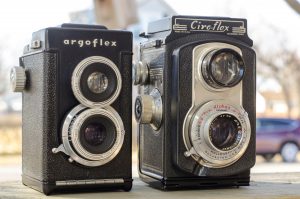
My Thoughts
Since the most logical comparison between the Argoflex EF and another camera would be the Ciro-Flex, I’ll start there with my thoughts.
From an aesthetic standpoint, the Argoflex feels sturdier than the Ciro. The solid metal body is both heavier and more solid than the sheet metal body of the Ciro-Flex. That’s not to say that the Ciro is flimsy, because it isn’t, but the Argoflex is built more like a solid metal brick than a hollow metal box. This shouldn’t be surprising because Argus has a reputation of making brick-like cameras with their C3 known simply as “The Brick”.
The Argus’ viewfinder lid opens easier and more smoothly than the one on the Ciro-Flex. To be fair, my Ciro’s lid was a bit warped and would hang on itself when opening and closing, so perhaps a Ciro in better condition wouldn’t have this problem, but I have to believe that the Ciro’s somewhat clumsily designed lid is at least partially responsible for why mine is the way it is. After all, there were many other TLRs made by many other companies, and a flimsy viewfinder lid is rarely a common complaint.
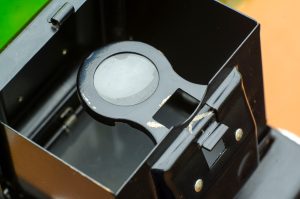
Speaking of the viewfinder, the Argus wins points for having a magnifying glass in a more traditional position. On most TLRs, including the Argoflex, the magnifying glass inside of the viewfinder is hinged on the back of the viewfinder. This puts it in a convenient position to swing out for precision focusing. The Ciro-Flex strangely has this feature, but its hinged on the front of the viewfinder, underneath the lid. This means you have to reach inside of the viewfinder with your fingers and pull it out. It’s not impossible to do, just awkward. Considering both of these cameras came out around the same time, and each company had several German TLRs to base their designs on, I find the position of the magnifying glass on the Ciro to be poorly thought out.
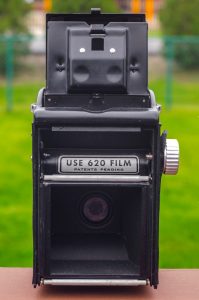
Probably the biggest con of this camera was Argus’ decision follow Kodak’s lead and use 620 film instead of more common 120 film. This is more frustrating because the original Argoflex E could use both 620 and 120, and Argus intentionally removed that feature on later models. This is even more important today since 620 film is no longer available. That doesn’t mean you cant still roll 120 into the camera, but there are challenges in doing so. You either need to modify the camera, re-roll 120 film onto 620 spools yourself, or buy pre-re-rolled 120 film on 620 spools from someone else. I talk a bit about how to re-roll 120 film onto 620 film in my review for the Kodak Medalist, so I won’t repeat it here.
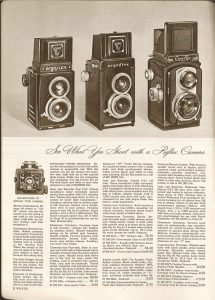
Another con is that the viewing glass is just a single piece of ground glass as opposed to the Fresnel screen of my Ciro-Flex which means it is quite dark. Now to be fair, not all Ciro-Flexes had the Fresnel screen. I believe that was a mid-model upgrade to the Models D and E, as earlier models had just a piece of ground glass like the Argoflex does. This means that using the Argoflex in anything but well lit scenes can be difficult, so the Ciro-Flex models with the Fresnel screen definitely win points for brightness.
Neither a pro or a con are the shutter and lenses because both cameras have the same exact Wollensak Alphax shutter and nearly identically lenses. This means that the quality of the images should be nearly identical. It’s worth mentioning that some Ciros did have a Rapax shutter which had a wider spread of shutter speeds and a slightly brighter f/3.2 lens, but not the one I own.
Both the Ciro Flex and Argoflex EF have flash synchronized shutters, which shouldn’t surprise anyone since they have the same shutter, but the Argoflex also has a hot-shoe on the side whereas the Ciro Flex has a standard cold shoe. It’s worth mentioning that the style of hotshoe on the Argus is not compatible with modern electronic flashes. You cannot simply attach a Nikon SB-600 Speed Light and use it on the Argoflex. You need to use the specific flash designed for it.
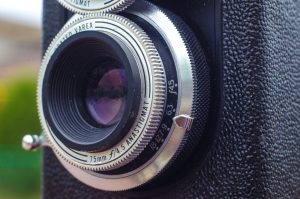
The final comparison between the two is the focusing design. I go back and forth trying to decide which I like better, the externally geared lenses on the Argoflex, or the more traditional moving front lens standard. While the Ciro-Flex’s design is more traditional, Ciro did not use the same approach that a higher quality TLR like the Rolleiflex or Yashica-Mat does. Ciro’s method involves a spiral piece of metal that is connected to a knob and upon rotating the knob, the spiral piece of metal pushes on a plastic shaft that slides the whole front lens assembly fore and aft. While effective, this design is prone to failure if too much pressure is put on the front lens standard. Over time, it could mean that Ciro-Flexes could lose their focus calibration which is exactly what happened to my Ciro. Plus, the plastic shaft that moves the front lens assembly could wear out after many years of use, and then there’s the issue of keeping that spiraled piece of metal lubricated sufficiently to make the whole design smooth.
The Argoflex design is much simpler, but in some ways, its more foolproof too. Apart from manually removing the gears, or causing some sort of trauma to the teeth, there is no way for this design to fail. There is almost no chance that the Argoflex could ever lose it’s focus calibration. Plus, this design means there are less moving parts and the entire body is more light tight and less likely to let dust in. It is a little more awkward to have to reach to the front of the camera to adjust your focus, but it is something you get used to very quickly, and in practice, isn’t that big of a deal.
So while maybe the Ciro has a more traditional and slightly easier to use focus system, the Argoflex’s simpler design is less likely to fail and allows for a better sealed camera. We’ll just call this one a tie.

As I’ve said a number of times, I never really sought out to acquire an Argoflex. I saw this one at an antique shop for $10. It was in rough shape, the shutter didn’t fire, and it was really dirty. Knowing what I knew about Alphax shutters and Argus’ reputation for making easy to repair cameras, I took a gamble that I’d be able to fix it up, which I did.
The darker screen, need for 620 film, and basic feature set mean it’s not a camera I think I’ll use often, but there is a level of elegance in it’s solid metal body and industrial design. It’s from a period in American photographic history where we didn’t have to compete with the Germans or the Japanese in sophistication. We could build simpler cameras that were reliable and capable of nice photographs, and do it for a much lower retail price.
My Results
Prior to shooting with this camera, I was fortunate to discover a small cache of expired Kodacolor II 620 film. I used this same film with great success in the Kodak Medalist, so I figured I would give it a try in the Argoflex as opposed to rolling 120 onto a 620 spool. This decision, combined with my choice for where I used the camera proved to not be the best circumstances to properly evaluate the camera, but I still feel as though I walked away learning something about it.
I said it earlier in this review, but it is worth repeating that the viewfinder is dark. This is probably the darkest viewfinder of any in my collection. It is very hard to properly focus on anything indoors or in poor outdoor lighting. I took this camera with me to trip to visit my in-laws in northern Michigan this past Christmas, and in hindsight, I probably should have left it home. I definitely need to come back and revisit this camera this summer when lighting conditions are more ideal for a camera with a dark viewfinder like this.
As I typically do when shooting extremely expired film, I show the original scans along with my edits in Photoshop. It is impressive how much can be pulled out using some simple tweaks.
I can see that the shutter is mostly accurate and the lens is capable of acceptable sharpness and resolution. The first three shots show noticeable vignetting in the corners. I find this to be typical of lenses of the era, and in my opinion, adds to the vintage look of the shots. There were a few other shots I got recent results from, but they were a bit out of focus, mostly due to my inability to properly compose the image using the dark viewfinder.

A good lesson I’ll probably repeat often in other reviews is that whenever you take out a camera you’ve never used before, you probably shouldn’t use expired film, and you definitely shouldn’t shoot it in northern Michigan during the winter. Despite stacking the odds against myself, I am still pleased with the results. I really want to try out this camera again in better conditions, but these images definitely give me something to look forward to for the next time I use it.
Edit 4/28/2017: It took me over a year to revisit the Argoflex to see how the camera would perform in more ideal lighting situations. Again, I used expired Kodacolor II, but made sure to overexpose every shot +2. Each of the images below are tweaked in Photoshop to bring out the contrast and vibrancy, but are otherwise unedited.
As you can see, the sharpness and pleasant vignetting of the Wollensak triplet remains. The Argoflex renders images nicely and with a very 1940’s look. The expired Kodacolor shines in this camera with muted colors and a soft contrast. I still did not enjoy the dim viewfinder on the camera and the long throw of the Alphax shutter is still something that takes getting used to, but if you are willing to persevere, the Argoflex EF is a very capable camera that is fun to use, and produces really nice images.
My Final WordHow these ratings work |
The Argoflex EF receives one of the lowest scores I’ve given a camera on this site, but I really think that number isn’t fair to the actual camera. This was an inexpensive camera that was designed to be rugged and reliable, and for the most part it still is, 68 years later which I think should count for something. The need for 620 film and the dark viewfinder are definitely the camera’s greatest weaknesses, but otherwise it delivers an experience consistent with TLRs from the 1940s. I plan on revisiting this camera in the future with some better film and in more ideal lighting, and perhaps I will revisit this rating at that time, but for now I’ll stick with what I have written. This isn’t a bad camera. Considering they often go for pennies on auction sites and are very easy to repair, I’d recommend them to anyone wanting to try out a well built and fun to use American TLR from the 1940s. | ||||||
| Images | Handling | Features | Viewfinder | Feel & Beauty | History | Age | |
| 1 | 1 | 0 | 0 | 1 | 0 | 30% | |
| Bonus | None | ||||||
| Final Score | 3.9 | ||||||
Additional Resources
http://www.arguscg.org/manuals/e/gaon-em-repair/
http://mattsclassiccameras.com/argoflex_e.html
http://camerapedia.wikia.com/wiki/Argus_Argoflex_EF
https://sites.google.com/site/fromthefocalplanetoinfinity/argus

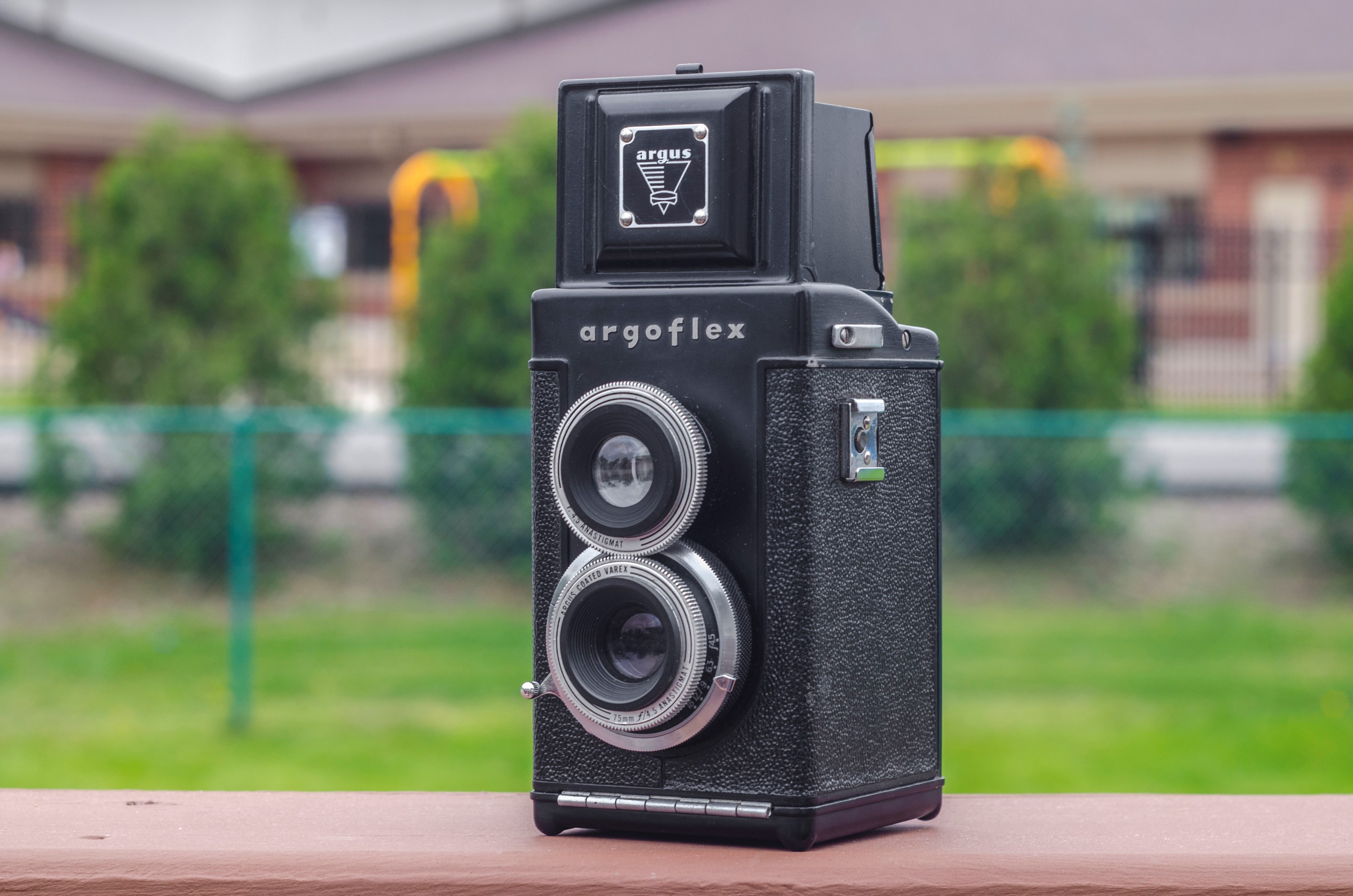

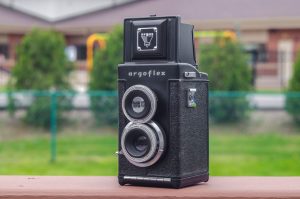
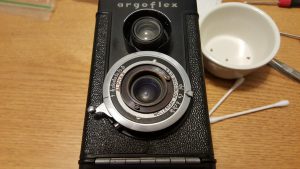


























Nice shots. Makes me want to try out my recently acquired argoflexes. I just got an early model EM, you can see where they filed the II off the casting and it seems to have the larger F3.5 viewing lens from the recalled Argoflex II model. I also have a prewar Argoflex E, and a postwar one I bought because its equipped with an interesting huge aftermarket King Sol flash gun with a trigger assembly that’s connected to the shutter release. its not often you see a camera without built in flash sync adapted to flash (except for press cameras)
what its dimensions??? pls reply asap
We just found an Argoflex EF in box with case, a ring & ALL original paperwork! Also, in box, a flash that fits it. Found in house after Father’s passing. Looks brand new! I vaguely remember him using when I was a child. He rarely took any pics at all, ever! Wondering if it has any value at all or where to take it to sell. He was an Iwo Jima survivor, and 95 yrs. old! Finding LOTS OF UNIQUE ITEMS! Thanks for any help!
Hi Sherry, what a cool find! I’ve never seen the Argoflex EF’s original packaging together with the camera before, so estimating it’s value is difficult. The camera by itself has very low value, but it’s possible to find an Argus collector who wants a set like that. Your best bet is going to be eBay or etsy. If you’re looking to donate it to the site, I also accept donations too.
Thank You so very much! We’ll have to decide!
I have a recently acquired an ArgoFlex that appears to be in excellent functional condition. I plan to clean it a bit before I load film in it. If I shoot B&W I will have to trim the lip of the 120 supply spool to fit and use a 620 take up spool. I do have some expired 620 color film but it is mid 1980’s vintage kodak film that was probably stored on closet shelf. I develop my own B&W but would have to send off the color. Mmmmm, decisions, decisions!
Nice shout out to a charming, little known TLR! My flea market example came with a stuck shutter and with both lenses completely out of focus and out of mesh, but there’s almost nothing on this camera a person of even moderate technical ability can’t fix. I have added some cheap modifications over the years; threw in a cheap fresnel magnifier to brighten up the viewfinder, drilled out an additional film window and added a matte for shooting 645, as well as modifying the giving and take up holders to accept 120 rolls. Far from my best camera and best when used on a tripod in my experience, but always fun and rarely a bad picture.
Wow! It sounds like you really went pretty far into customizing your Argus EF! Those things are well built cameras, but the dim viewfinder is their biggest con, but it sounds like you improved yours! The Wollensak lenses on them are quite good, so I am sure you are getting really nice images from it. Thanks for sharing your experience.